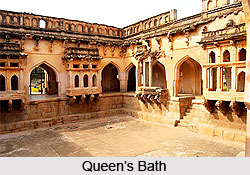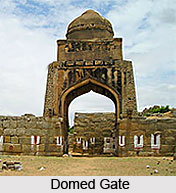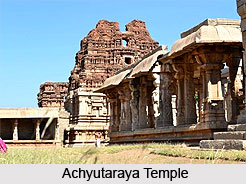 Hampi is located in Bellary district and since1565 to 1800 AD, various rulers reigned the land of Hampi. The history of Hampi is depicted in the stone sculptures and architectures that are scattered in all nooks and corners of this land.
Hampi is located in Bellary district and since1565 to 1800 AD, various rulers reigned the land of Hampi. The history of Hampi is depicted in the stone sculptures and architectures that are scattered in all nooks and corners of this land.
The dominion of the Sultans, following their victory at Talikota, was tenuous and the region was split up into small principalities under chieftains known as "poligars". Aurangzeb annexed these territories. Afterwards the area was dominated by the Maratha emperors and still later by Hyder Ali and Tipu Sultan of Mysore . However, through all these changes, the "poligars" continued to hold local authority. At the partition of Tipu"s territory in 1792, part of the district fell to the Nizam. At the further division, which occurred after Tipu"s defeat and death in 1799, the Nizam obtained the rest of it and ceded both these portions and the adjoining area to the British Empire in 1800. These Ceded Districts were added to the Madras Presidency, of which it remained a part till Indian Independence and the States Reorganization, when Bellary district became a part of Karnataka State .
The name and fame of the fabulous city of Vijayanagara had spread early outside India due to foreign visitors to the city. The history of Hampi incorporates the saga of struggle against the northern Sultanates and situating the capital of Vijayanagara in Hampi which was reckoned to be one of the important centres of trade. Being patrons of art, culture and religion, the rulers of Hampi founded several instances of great art that remain exemplary of this place till date. During the reigning period of King Krishnadeva Raya from 1509AD -1529 AD, who was from the Tuluva Dynasty, Hampi experienced success and prosperity.
After the British seized the area scholarly investigations at Hampi-Vijayanagara started and the first modern account is that of the antiquarian Colonel Colin Mackenzie, later to be Surveyor-General of India. Travelling through the Deccan, noting monuments, copying inscriptions and collecting manuscripts,Mackenzie visited Vijayanagara in 1800. The present remnants of the architectural buildings, monuments and temples in Vijayanagara and Hampi provide historical and archaeological information and attempted to give a comprehensive picture of the kingdom and its capital. Some monuments on Hemakuta hill, which were on the verge of total collapse, were dismantled stone by stone and then completely rebuilt. All the major monuments, as well as several minor ones, received attention; among the temples that were repaired were the Vitthala temple, Krishna temple, Hazara Rama (Ramachandra) temple, Achyutaraya (Tiruverigalanatha) temple, Pattabhirama temple, Ganigitti temple, Sarasvati and Rariga temples. Secular structures such as the "Queen"s Bath", "Mahanavami Platform", "Guards Quarters", "Muhammedan Watch Tower", "Domed Gate" and many others were also in the list of renovation. The actual repair work was carried out by the Public Works Department of the Government of Madras,
 and watchmen were appointed to look after the principal monuments. It was during this clearance work that lumps of charcoal and calcinated iron were found and cited as evidence of the 1565 conflagration which destroyed the city of Vijayanagara.
and watchmen were appointed to look after the principal monuments. It was during this clearance work that lumps of charcoal and calcinated iron were found and cited as evidence of the 1565 conflagration which destroyed the city of Vijayanagara.
Several excavations has been carried out at Hampi and these excavations reveal complete plan of the medieval city and to throw light on the life of the people in the city. The main excavation locations are the "Royal Enclosure", the temples in the "Pan-supari bazar", the area to the east of the Hazara Ramachandra temple and in the "Danaik"s Enclosure". The Royal Enclosure is a large area of 59,400 square metres, where monuments such as the Mahanavami Platform and the King"s Audience Hall were free-standing. The rest of this area was a wilderness of huge stones, debris, rubble and shrubs prior to 1976. Among the structures that were uncovered was a palace complex, where excavations yielded a large number of Chinese porcelain shards, miniature sculptures and lingas made of crystal. In the area south of the palace complex the basements of ten long rectangular pillared halls in a row and two other rectangular structures were exposed.
The outstanding discovery was that of a fairly large, unique stepped tank, unearthed in the mid-1980s. Built of well-dressed schist blocks, it is 22 metres square on plan and seven metres in depth. The tank is built in a stepped order and is provided with five landings. Every part of this tank contains a small inscription or mason mark. This indicates that it was a prefabricated structure, the architectural pieces having been brought from the manufacturing centre and assembled in the stepped pit that had been dug out, with mason-marks providing clues as to how the reassembling was to be done. The excavations in this enclosure have also exposed arrangements for water supply and drainage.
 The excavation conducted in the temple complex behind the Elephant Stables, in the "Pan-supari bazar", have exposed four half-buried temples, of which two were Jain, one Shaiva and the fourth Vaishnava in affiliation. To the east of the Ramachandra temple, a few shrines and other structures have been uncovered.
The excavation conducted in the temple complex behind the Elephant Stables, in the "Pan-supari bazar", have exposed four half-buried temples, of which two were Jain, one Shaiva and the fourth Vaishnava in affiliation. To the east of the Ramachandra temple, a few shrines and other structures have been uncovered.
Some of the inscriptions that are derived from excavations have helped in the identification of a number of religious and secular structures. By the end of the twentieth century, Vijayanagara has definitely been revived, both for scholars and the general public as Hampi - Vijayanagara had gained popularity among them. The site has been placed by UNESCO on its list of "World Heritage Monuments".
With time, Hampi-Vijayanagara has gained the epithet of being a well-known archaeological site, both in scholarly circles as well as on the tourist beat. This opening up of Hampi has been a mixed blessing. On the one hand, it has become better known and easily accessible, but on the other, the increase in development and tourism have brought in its wake new hazards to the site and its monuments. Thus, for these recently made excavations and findings, the history of Hampi has attained a clearer view to the people who are interested in this ancient site.



















